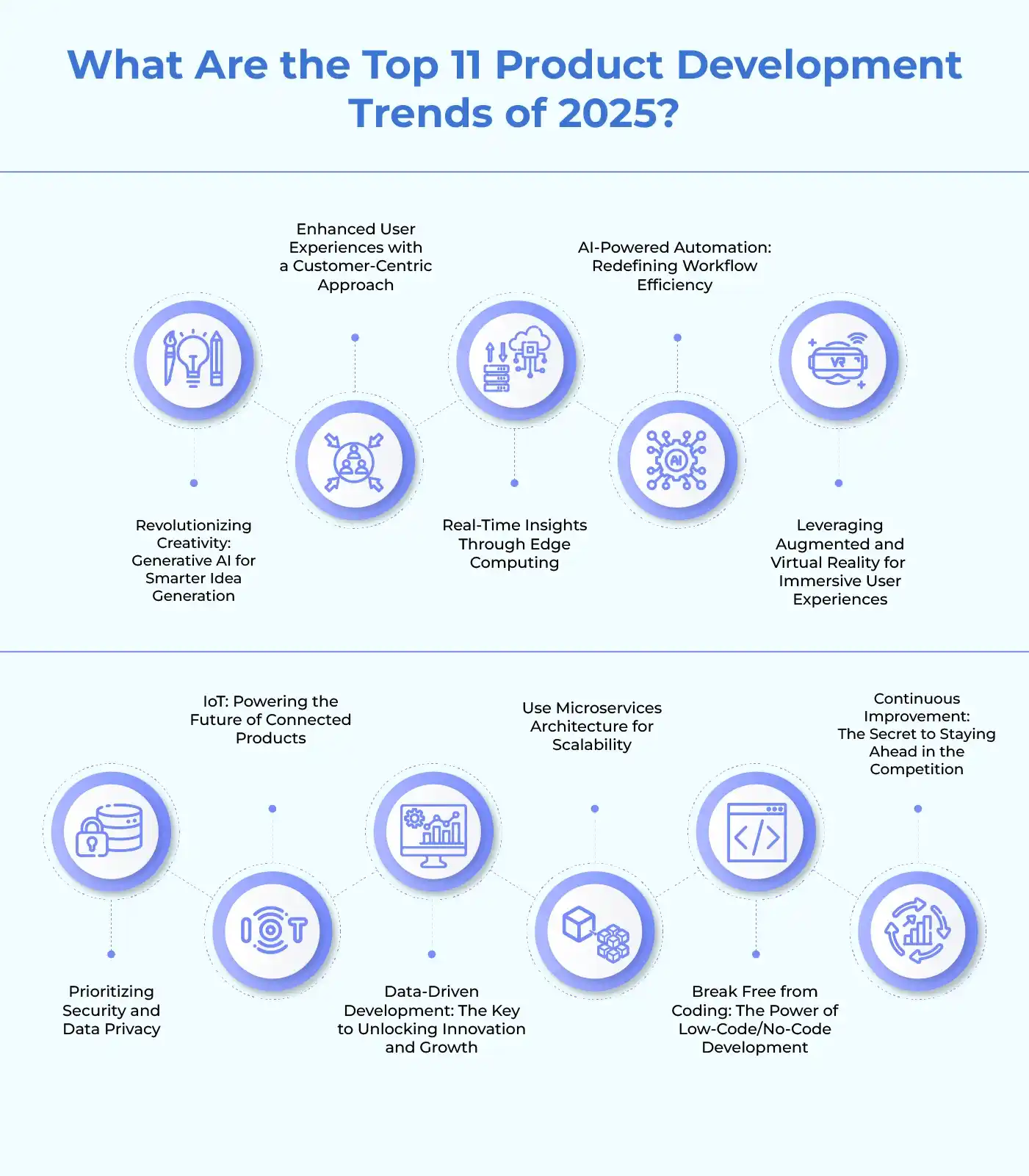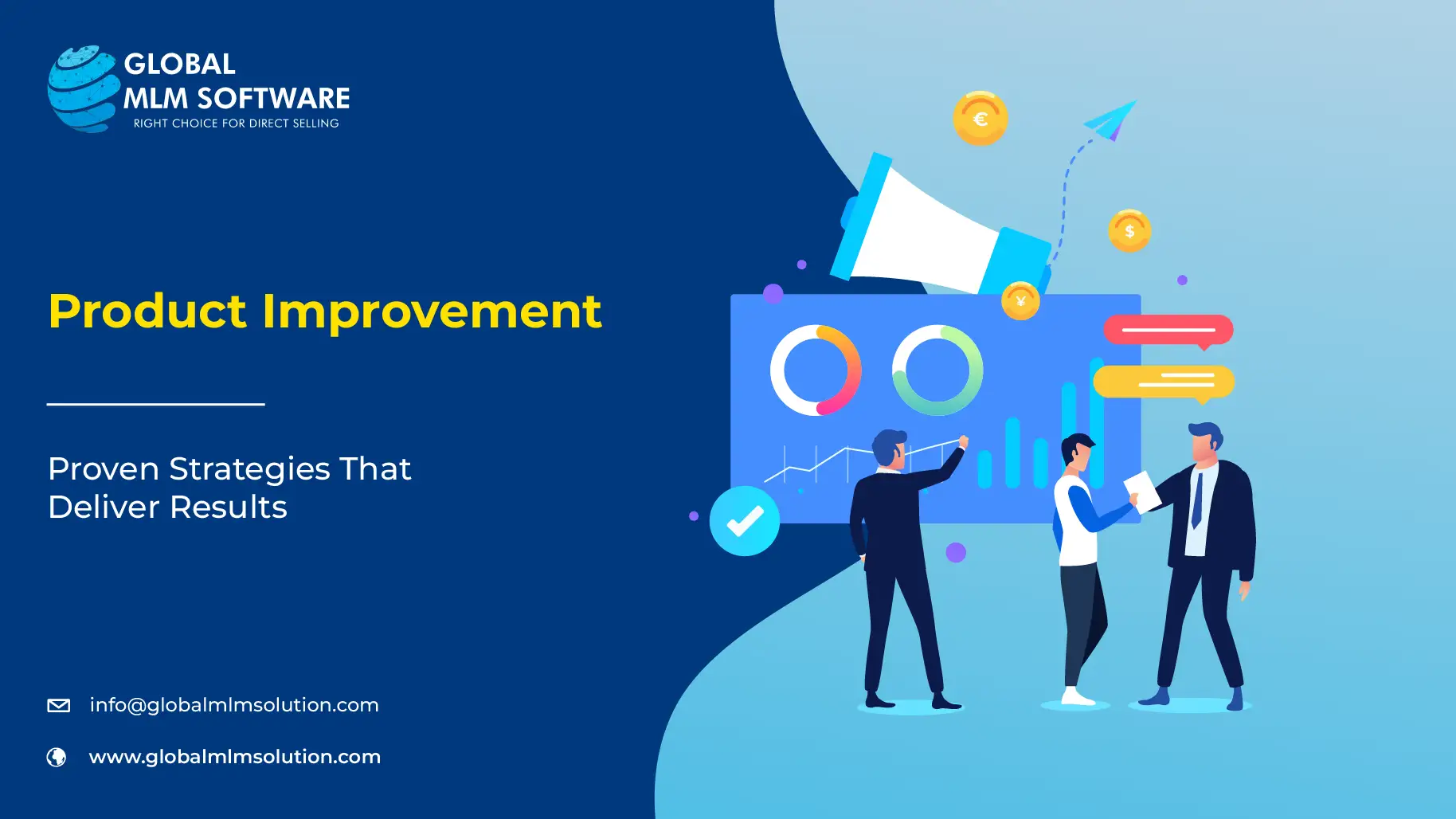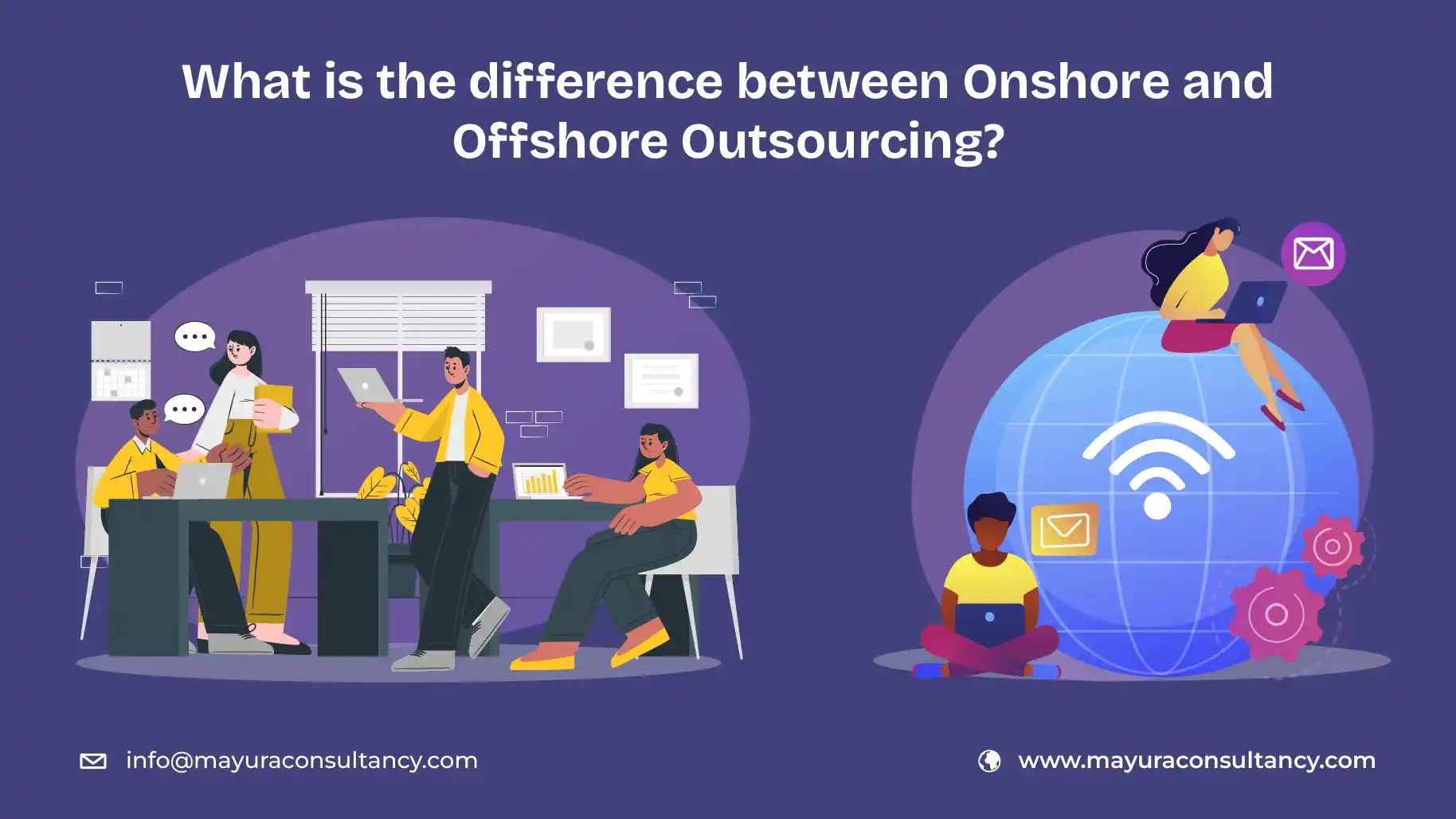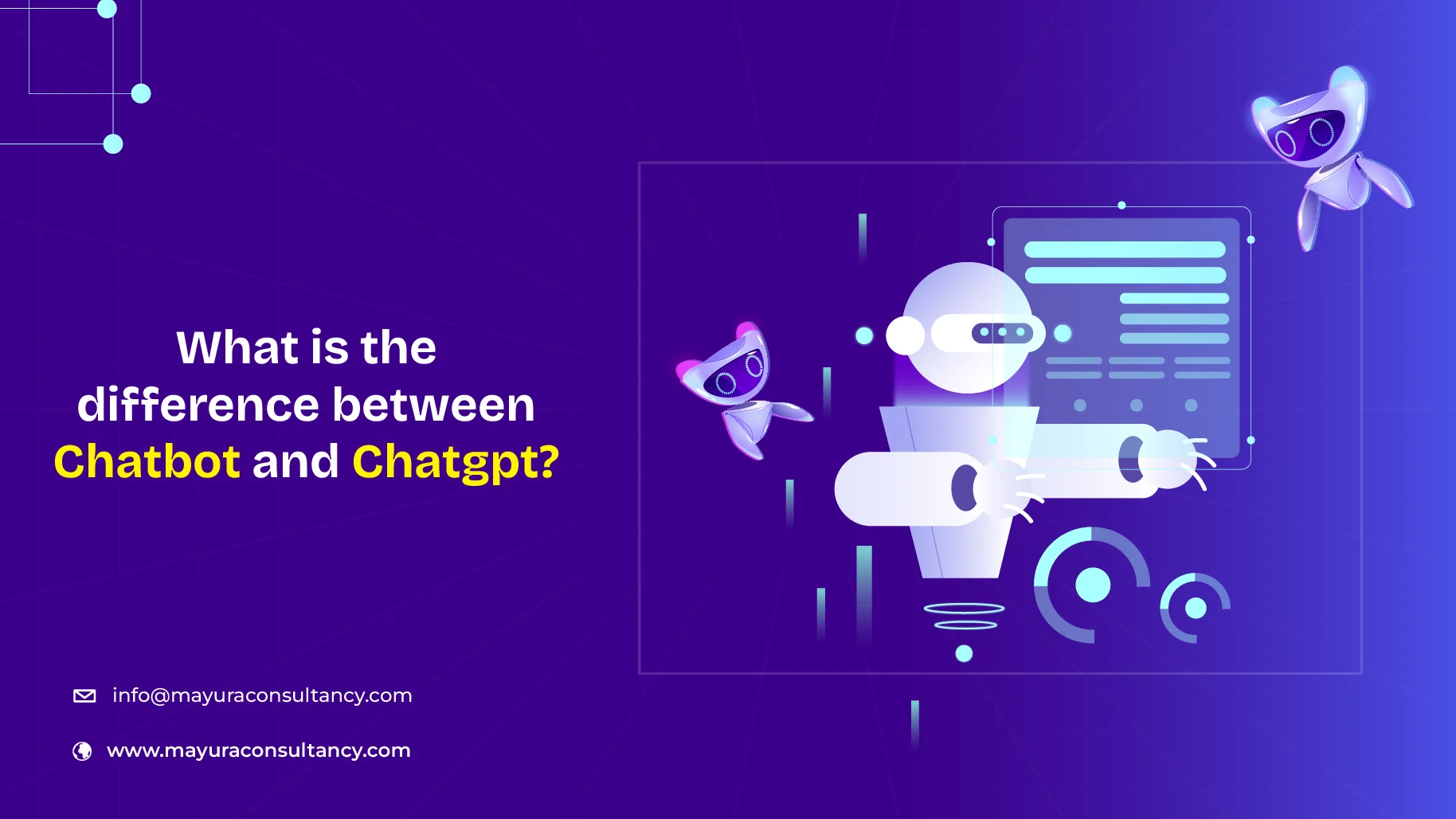In a dynamic world where speed and innovation are crucial for business success, can you afford to build a software product that could be outdated tomorrow? Staying one step ahead of your competition and anticipating tomorrow's needs is the key to building a successful product.
As we approach 2025, new product development trends like AI, IoT, augmented reality, and others will shape the future of product development. In this blog, we will explore the top product development trends and how integrating them will enhance your product.
This Article Contains:
Top Product Development Trends Businesses Must Adopt in 2025
Adopting the top trends in product development is crucial for businesses to stay competitive and future-proof their software product. Here are the most popular trends to watch in 2025.

1. Revolutionizing Creativity: Generative AI for Smarter Idea Generation
Finding new product development ideas is time-consuming but can you shorten it?
It might have been difficult a few years ago, but with generative AI, you can accelerate brainstorming sessions and find breakthrough ideas quickly. Generative AI revolutionizes idea generation by leveraging machine learning to analyze patterns, trends, and vast datasets to propose innovative solutions.
Whether crafting new product features, exploring market opportunities, or prototyping creative designs, Generative AI streamlines the product ideation process. This revolutionary technology does not replace human creativity but acts as a collaborator and offers unique perspectives and insights that might be overlooked.
Benefits:
Speeds up the ideation process with actionable insights.
Reduces creative bottlenecks, enabling teams to act faster.
Offers data-backed solutions, minimizing the risks of trial and error.
2. Enhanced User Experiences with a Customer-Centric Approach
How do you create a software product that exceeds user expectations? The answer lies in adopting a customer-centric approach while designing and developing the product. A user-centric mindset is among the major product development trends in 2025, that focuses on understanding user preferences, behaviors, and pain points. This helps businesses to create intuitive interfaces and seamless experiences.
Companies adopting a customer-centric approach go beyond aesthetics and surface-level features. They gather customer feedback throughout the product's lifecycle to refine it, ensuring the product meets user expectations.
Be it ecommerce platform development or SaaS development, focusing on user experience helps you stay at the top in a competitive market.
Benefits:
Improves user satisfaction and retention rates.
Encourages product adoption among new customers.
Builds stronger brand loyalty and trust.
3. Real-Time Insights Through Edge Computing
Edge computing is a powerful technology that provides real-time insights by processing data close to the source. This reduces latency and facilitates quick decision-making, which is essential for applications that require real-time insights.
Industries like healthcare, smart cities, and autonomous vehicles leverage edge computing to enhance decision-making and improve operational efficiency. For example, autonomous cars rely on edge computing to analyze real-time data from sensors and cameras, enabling the car to make instant decisions.
Benefits:
Reduces latency and speeds up data processing.
Enhances operational efficiency with real-time insights.
Reduces dependency on the cloud for data processing.
4. AI-Powered Automation: Redefining Workflow Efficiency
AI-driven automation is transforming how businesses operate by streamlining repetitive tasks across various functions. AI development and integration can revolutionize workflow by handling repetitive tasks such as data entry, customer support, report generation, etc.
From AI chatbots addressing customer queries instantly to predicting potential equipment failures in manufacturing, AI-powered analytics optimizes business operations. This allows your team to focus on complex tasks where human intervention is essential. Moreover, AI integration enhances the accuracy and consistency of processes, minimizing the risk of human error.
Benefits:
Improves productivity by reducing manual workloads.
Increases operational efficiency and consistency.
Frees up employees’ time to focus on innovation.
5. Leveraging Augmented and Virtual Reality for Immersive User Experiences
With technologies like augmented and virtual reality (AR/VR) you can create immersive experiences for your users and engage them like never before. Remember the game Pokémon that took the world by storm in 2016, with over 228 million downloads in its first quarter? The game used AR technology.
But what is AR/VR technology?
AR is a technology that overlays digital elements onto the real world, like seeing how a new sofa fits in your living room. On the other hand, VR takes you into a virtual world like walking through a dinosaur park with a VR headset.
From online shopping to virtual property tours, AR and VR bridge the gap between the physical and digital worlds. Industries such as education, healthcare, ecommerce, games, etc. are adopting AR and VR to bring innovation and improve user experience.
Benefits:
Delivers engaging, immersive experiences for users.
Boosts sales and conversions through virtual product demonstrations.
Improves customer satisfaction and decision-making.
6. Prioritizing Security and Data Privacy
Are you aware that the cost of a data breach has grown significantly in 2024?
According to an IBM report, the global average data breach reached USD 4.88 Million in 2024, a 10% increase over last year and the highest ever. As a result, software product development companies are prioritizing data security and privacy, making cybersecurity one of the top product development trends.
With the rise in cyber threats and data breaches, companies should adopt stringent security measures throughout the software development lifecycle. This includes encryption, multi-factor authentication, and ensuring compliance with data protection regulations such as GDPR, CCPA, and HIPAA.
By prioritizing security from the beginning, enterprises can prevent costly breaches and protect the brand’s reputation and trustworthiness.
Benefits:
Safeguards sensitive business and customer data.
Strengthens brand reputation by building trust.
Ensures compliance with global privacy standards.
7. IoT: Powering the Future of Connected Products
Internet of Things (IoT) has emerged as one of the top product development trends in 2025 for obvious reasons. This new-age technology is transforming industries with smarter and connected products that deliver convenience and efficiency.
Let's see the use cases of IoT in different industries.
Automotive : IoT-enabled vehicles provide real-time diagnostics, offer predictive maintenance, and improve road safety.
Manufacturing : Connected machinery can identify inefficiencies, predict maintenance needs, streamline production, and reduce downtime.
Retail : IoT-driven smart shelves can automatically track inventory and notify staff of low stock.
Healthcare : Wearable devices can monitor patient's conditions in real time, improving treatment and reducing hospital visits.
Agriculture : IoT-powered sensors optimize irrigation, saving water and boosting crop yield.
As IoT adoption grows, businesses leveraging this technology can unlock new possibilities, stay competitive, and deliver more value to their customers.
Benefits:
Enhanced user experiences through smart, connected product features.
Real-time data insights to improve decision-making.
Increase efficiency with predictive maintenance.
8. Data-Driven Development: The Key to Unlocking Innovation and Growth
Why is data-driven product development so critical? Let's understand from a report.
According to McKinsey, data-driven businesses are 23 times more likely to stay ahead of competitors in customer acquisition, about 19 times more likely to remain profitable, and seven times more likely to retain customers.
Data-driven product development helps businesses create applications that address real-world needs. By leveraging hidden insights and trends, companies can make informed decisions about their products' features, design, and functionality.
This not only improves user satisfaction but also ensures that every investment in development aligns with strategic goals.
Benefits:
Aligns product features with user needs.
Reduces development risks with informed decisions.
Improves customer satisfaction and ensures product success.
9. Use Microservices Architecture for Scalability
Among the top software product development trends, microservices architecture continues to be popular.
But what exactly is microservices architecture?
It is a modern approach to building applications by breaking them into smaller, independent modules. Each component focuses on a specific function, such as payment processing or user authentication, and can operate independently. This flexibility allows businesses to develop features quickly.
Moreover, unlike monolithic architectures, which are difficult to maintain, microservices allow organizations to respond quickly to market demands and technological changes. Each service can be developed in different programming languages and maintained by separate teams, reducing development bottlenecks.
For example, if your streaming platform faces a surge in viewership during a major event, you can scale the video streaming infrastructure without impacting other features like user authentication, search, subscription, admin dashboard, etc.
Benefits:
Enhances scalability to meet fluctuating demands.
Simplifies system maintenance and updates.
Reduces downtime with modular functionality.
10. Break Free from Coding: The Power of Low-Code/No-Code Development
Can your team build a robust software product without extensive coding knowledge? It wouldn't have been possible a few years ago, but low-code/no-code developments have become one of the top software product development trends.
With drag-and-drop interfaces and pre-built templates, these platforms reduce dependency on skilled developers, allowing even non-technical teams to create robust software products. According to a Straight Research report, Microsoft has highlighted a 45% reduction in app development costs with its Power Platform.
This trend democratizes product development, enabling faster prototyping and reducing time-to-market. Companies looking for cost-effective software solutions can leverage low-code/no-code platforms to launch new software products.
Benefits:
Reduces development time and costs significantly.
Increases collaboration between technical and non-technical teams.
Provides scalability for changing business demands.
11. Continuous Improvement: The Secret to Staying Ahead in the Competition
Developing a successful software product is a continuous process that does not end with the product launch. Product improvement is an approach that involves refining and optimizing the software to ensure it outperforms the competition.
Adopting effective product improvement strategies allows your business to address customer pain points, add relevant features, integrate the latest technological advancements, and align the product with evolving user expectations. This approach is particularly effective in product development for dynamic industries like ecommerce, ed-tech, entertainment, etc.
Benefits:
Keep your product relevant in fast-changing markets.
Increases user satisfaction and loyalty.
Helps in building stronger relationships with customers.
Final Takeaway
The future of product development is exciting as new trends emerge regularly. From low-code platforms simplifying development to AI-driven innovations redefining user experiences, businesses adopting the top product development trends can unlock new opportunities and stay competitive.
At Mayura Consultancy Services (MCS), we specialize in crafting innovative software products tailored to your unique business needs. Schedule a consultation to discover how MCS can help you achieve your product development goals.
Frequently Asked Questions
Adopting the top trends in product development enables businesses to stay competitive, improve customer satisfaction, and increase efficiency. It also reduces costs and improves ROI.
To prioritize user needs, companies should conduct user research, gather feedback, and integrate the top trends into their products. This ensures the products meet user expectations, leading to higher adoption rates and customer satisfaction.
The cost of software product development depends on factors like product complexity, features, and development timelines. At MCS, we offer a detailed estimate after discussing specific project requirements.
MCS stands out as a software product development company through its customer-centric approach, deep industry knowledge, and expertise in emerging technologies. We adopt the top product development trends to build high-quality software products that can transform businesses.






